Приказ основних података о документу
Fluoride content and recharge ability of five glassionomer dental materials
| dc.creator | Marković, Dejan | |
| dc.creator | Petrović, Bojan | |
| dc.creator | Perić, Tamara | |
| dc.date.accessioned | 2020-07-02T12:18:40Z | |
| dc.date.available | 2020-07-02T12:18:40Z | |
| dc.date.issued | 2008 | |
| dc.identifier.issn | 1472-6831 | |
| dc.identifier.uri | https://smile.stomf.bg.ac.rs/handle/123456789/1407 | |
| dc.description.abstract | Background. The relationship between fluoride content and fluoride release for glass-ionomer cements is not well understood. The aim of this laboratory study was: to determine the fluoride concentrations at the surfaces of glass-ionomer materials with respect to different storage media and different pH environments; to examine the recharge ability of the materials after NaF immersion; and to assess the morphological changes at the material surfaces using scanning electron microscope and energy dispersive spectroscopic techniques (SEM/EDS). Methods. Five glass-ionomer materials, Fuji Triage (FT), Fuji II LC (FII), Fuji VIII (FVIII), Fuji IX GP (FIX), and Ketac N100 (KN), were analyzed in this study. Resin-based fluoride releasing material Helioseal F (HSF) was used as a comparison material. The sample consisted of 120 cured cement disks (n = 20 disks of each tested material, 10 × 1.5 mm). Five disks of each material were stored in 4 different storage media (I- saline, II- acidic solution ph = 2.5, III- acid solution ph = 5.5, IV- NaF solution (c = 500/106). After 7 days, two disks of each material were transferred from media I, II and III to the NaF solution for 3 min. EDS analysis was conducted in 3 randomly selected spots of each experimental disk. SEM was used to determine morphological characteristics of the material surface. Differences between the experimental groups have been analyzed using Student's t-test with the level of significance set at p lt 0.001. Results. FT showed the highest fluoride content at the surface of the material. The lowest amounts of fluoride ions were detected at the surfaces of the FT disks stored at low pH environments, and this difference was statistically significant (p lt 0.001). Glass-ionomers showed significantly higher fluoride concentrations when compared to the HSF (p lt 0.001). After immersion in the NaF solution, fluoride concentrations at the surfaces of the disks increased when compared with previous storage media (FT>FVIII>KN>FII>FIX). SEM analysis of the surface morphology revealed numerous voids, cracks and microporosities in all experimental groups, except for KN and HSF. More homogenous material structure with more discrete cracks was observed in samples stored at neutral pH environment, compared to disks stored in acidic solutions. Conclusion. The tested materials could be considered as promising dental materials with potential prophylactic characteristics due to their relatively high fluoride content, but also the ability to extensively reabsorb fluoride ions, especially in acidic environments. | en |
| dc.rights | openAccess | |
| dc.rights.uri | https://creativecommons.org/licenses/by/4.0/ | |
| dc.source | BMC Oral Health | |
| dc.title | Fluoride content and recharge ability of five glassionomer dental materials | en |
| dc.type | article | |
| dc.rights.license | BY | |
| dcterms.abstract | Перић, Тамара; Марковић, Дејан; Петровић, Бојан; | |
| dc.citation.volume | 8 | |
| dc.citation.issue | 1 | |
| dc.citation.other | 8(1): - | |
| dc.identifier.doi | 10.1186/1472-6831-8-21 | |
| dc.identifier.scopus | 2-s2.0-49549085516 | |
| dc.identifier.fulltext | https://smile.stomf.bg.ac.rs/bitstream/id/230/1402.pdf | |
| dc.type.version | publishedVersion |


